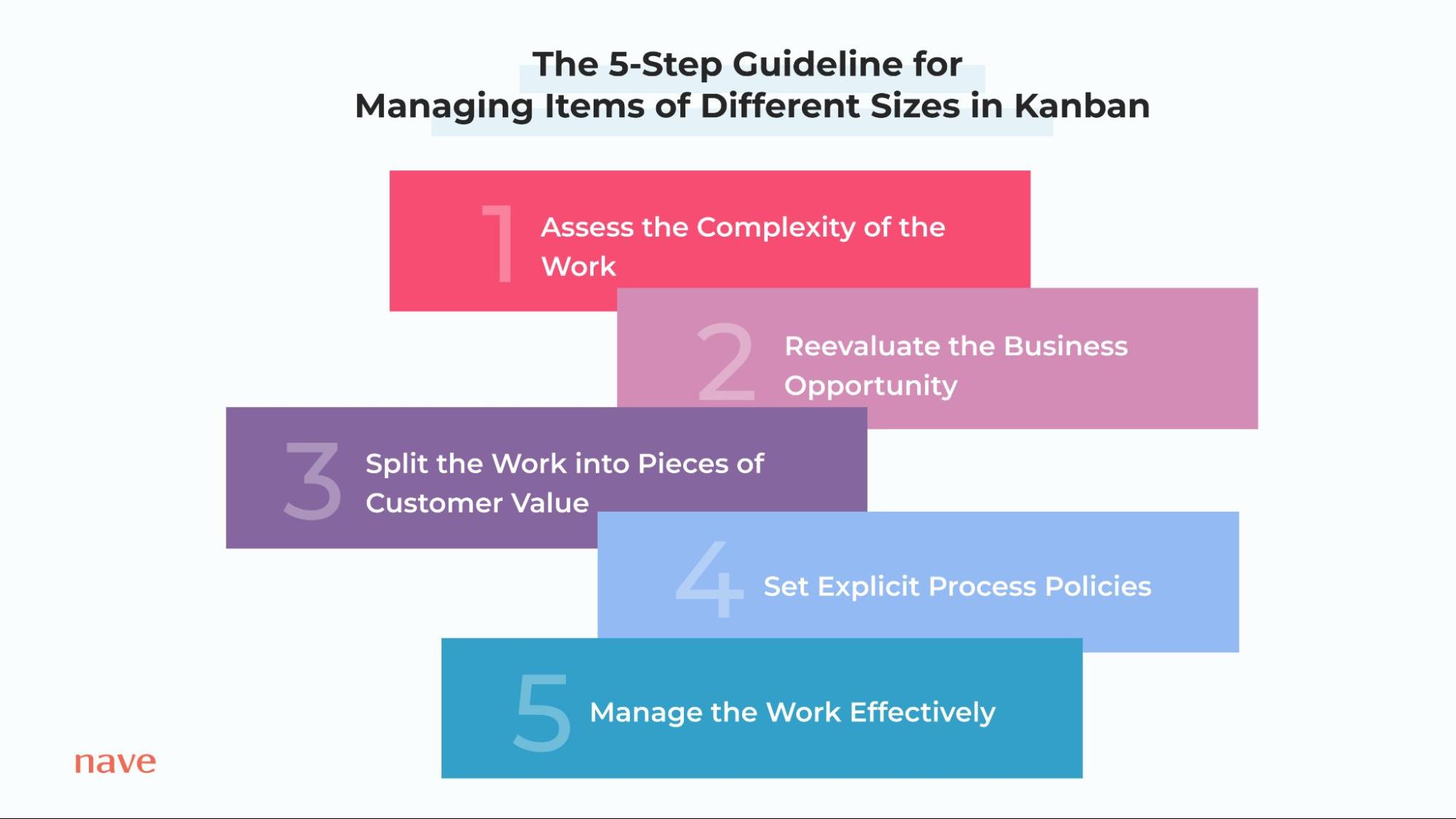This post is republished with permission from Nave. Nave uses data from TopLeft to make agile charts for analyzing workflow efficiency and identifying areas for improvement in your team. Learn more here.
“Kaban doesn’t work for us because we don’t have items of the same size” – If I had a dollar for every time I heard this statement, I could afford to spend my time laying on the beach in the Maldives all day long, all year round.
Let’s start from the basics. The Kanban Method turned a new page in the Agile world and moved the focus from spending time and effort on estimating our work to doing the actual work itself. You don’t have to count hours or story points to come up with reliable delivery commitments anymore.
“But Sonya, If we don’t estimate our work, how do we know when we’ll be done?”, you might ask. Well, first, you optimize your delivery process for predictability and then, you use your past performance data to get that answer.
The answer will simply look something like this, “We’ll be done in less than 10 days and we are 85% certain we’ll hit that target“. And this commitment will be valid for any type of work.
Now, I can bet I know what you’re thinking! “Sonya, this will only work if we split our items into even sizes!”. No, it won’t. And here is why.
Did I say the effort needed to finish any type of work must be exactly 10 days? No, I didn’t. Always remember, effort time and delivery time are not the same things.
Did I say that we’ll deliver any task in exactly 10 days? No, I didn’t.
What I said is that we’ll deliver the work in less than 10 days. Most probably we’ll be done earlier but it won’t take us more than 10 days and there is an 85% probability that we can achieve our goal.
How can I be so certain? Well, I am certain because it all boils back down to the predictability of our delivery system. It all depends on what management practices and process policies we have in place to make this happen.
The 5-Step Guideline for Managing Items of Different Sizes in Kanban
So, how can we keep our delivery times within the threshold of 10 days when the work our customers request comes in all different shapes and sizes? If we don’t split them into even pieces, how are we going to keep that commitment?
Let’s assume that a new request just arrived and the nature of the work is complex. Our gut says that the effort time on its own will most probably exceed 10 days.
In order to preserve the consistency of our delivery times, what we do in cases like this is adjust our management practices to make sure we still deliver on time.
And here is what our 5-step guideline for managing items of different sizes looks like.
The 5 steps to manage complex work effectively are assessing the complexity of the work, reevaluating the business opportunity, splitting the item into pieces of customer value, setting explicit policies and finally, managing the work effectively to make sure we preserve the predictability of our delivery times.
Let’s explore each of them in more detail.
Step #1: Assess the Complexity of the Work
The first step to handling items of large sizes is to identify them.
Now, we decide what are the most important things we should focus on next during our weekly replenishment meetings. And they are split into two parts – analysis and forecasting.
The main goal of the analysis part is to gain an understanding of the problems we’re trying to solve. During the analysis, we unambiguously define the What and Why. The most important thing is the conversation regarding what needs to be done, why we’re doing it, and for whom we’re doing it.
The main goal of the forecasting part is to evaluate whether there is a risk of breaking our 10-day commitment. We usually spend just a couple of minutes performing this assessment.
During the forecasting process, the only question we are interested in is “Would the effort time needed to complete this work item exceed 10 days? Will it fit within our threshold?”. If the answer is no, we no longer have to talk about it because we know that our process policies guarantee we’ll deliver the work within 10 days. So, we move on to the next item. If the answer is yes though, then we continue the conversation.
Step #2: Reevaluate the Business Opportunity
The second step of managing work items of different sizes in Kanban in the best possible manner is reevaluating whether that big task is really a priority at the moment.
Ask the following questions:
“Is that initiative going to realize a market opportunity? If we start it now, is it going to realize a return on investment right away for our business?”. And if you’re positive that’s the case, you’ll start working on this item right away, of course. If that’s the highest priority, you will initiate the work as soon as possible, naturally.
If you’re in doubt though, I’d highly advise that you don’t start that piece of work right now. Otherwise, you’ll be reserving capacity for work that is not yet due and run out of capacity for work that actually is due.
In fact, when I work with managers in our program, I often see big pieces of work with a low priority stuck in the workflow. These items have the potential to ruin your predictability and cause major inefficiencies in terms of flow. As a rule of thumb, regardless of its complexity, if the work is not important, don’t initiate it.
Step #3: Split the Work into Pieces of Customer Value
The third step for handling complex work items effectively is to question whether we have come up with the most feasible solution from a customer’s perspective. Is it possible to split that story into multiple chunks that still bring value to our customers? And naturally, these chunks will be of different sizes!
So, when it comes to splitting stories you should always approach it by putting yourself in your customer’s shoes. You don’t want to cut your stories artificially just to fit into a timebox or to make your metrics look nicer. This is wrong! Ask yourselves, “Is there an alternative approach that will solve our customer’s problems? Is there anything else we can do, something smaller, something easier, that will still help them achieve their goals?”.
When you’re splitting your stories, think about what is the easiest and fastest way to provide a deliverable to your clients. The goal is to deliver results and collect their feedback sooner so you can adjust your course accordingly.
A word of caution here: splitting your stories is a continuous process. It’s a perfectly valid scenario that your team may be working through a story in the development workflow, and find that the story turns out to be way more complicated than you initially assumed. In this case, you go through this step again.
Step #4: Set Explicit Process Policies to Handling Complex Work Items
So, if this big item is the highest priority at the moment, in terms of effort it will take more than 10 days to be developed and it can’t be split into smaller pieces that still solve your customer’s problem, you have to make sure that the team is entirely focused on finishing that work.
In order to achieve that and reduce context switching as much as possible, you should introduce an explicit policy to temporarily stop accepting new work until you finish that item.
This approach will enable you to handle complex work effectively from multiple perspectives.
First, you promote pair programming and remove knowledge silos. Your team members will pair together to work on the big item. Essentially, what you do is allocate more capacity to that specific piece of work.
Second, you reduce distractions and multitasking; the main goal of the team becomes to deliver this high-priority work item.
And last but certainly not least, you eliminate all the opportunities of any other items to borrow time from this big chunk of work. It has the highest priority now and you want to set up an environment of effective collaboration to make the work move through the process smoothly.
Once the big item is released you can move back to your initial capacity allocation.
Step #5: Manage the Flow of Work Effectively
Once the work has been started, you need to manage it effectively to make sure you keep your commitment.
So, the team needs to be focused on working on that item and if there are any impediments, bottlenecks, blockers or dependencies that arise, you resolve them right away.
And that’s not only valid for complex work items, that rule applies in general. You should always strive to reduce the waiting time that your work spends in the system. Furthermore, keep track of the obstacles that cause that waiting time and address them during your retrospectives.
Take action accordingly and evaluate how the changes you implement affect your performance metrics, as well as how your team feels about the new way of working. Meet all objections proactively. That’s why it is important to always make one small step at a time. That’s how you achieve evolutionary improvement that is here to stay.
I have to tell you, in this article we just scratched the surface. If you’re struggling to deliver on your commitments and you want to build self-managed teams and a system that self-optimizes for predictability, I’d be thrilled to welcome you to our Sustainable Predictability program.
Here is your today’s action item! We’ve prepared the Kanban Cheat Sheet to Managing Work Items of Different Sizes for you. Download this checklist and keep it handy during your replenishment meetings when you’re selecting the work items you’ll handle next. As long as you keep all the boxes checked, you’ve taken the steps toward preserving the consistency of your delivery times.
And, if you’ve done the work, and there are items that still take longer than you anticipated, then that’s perfectly fine. That’s just the nature of your work.
If you have work of this nature now, it’s highly likely that you will have work of this nature in the future as well. That data will gradually build up on your historical performance.
Your delivery time trends and your thresholds will adjust accordingly. You do want to account for that data to be able to manage realistic expectations. Ultimately, the goal is to build a delivery system that enables you to make reliable delivery commitments in just a couple of minutes and spend your time on what matters the most – delivering customer value.
And remember, it’s not about the size of your work items, it’s all about how effectively you manage your workflow. The only prerequisite to hitting your targets consistently is to optimize your systems for predictability.
And if you still hear that the Kanban Method only works for items of the same size, please share this article on your social media channels using the buttons on your left. My goal is to break this paradox once and for all. I’d be grateful if you spread the word.
Alright my friend, I hope you found that piece of content valuable and I’ll see you next week, same time, same place for more managerial goodness. I wish you a productive day ahead!

